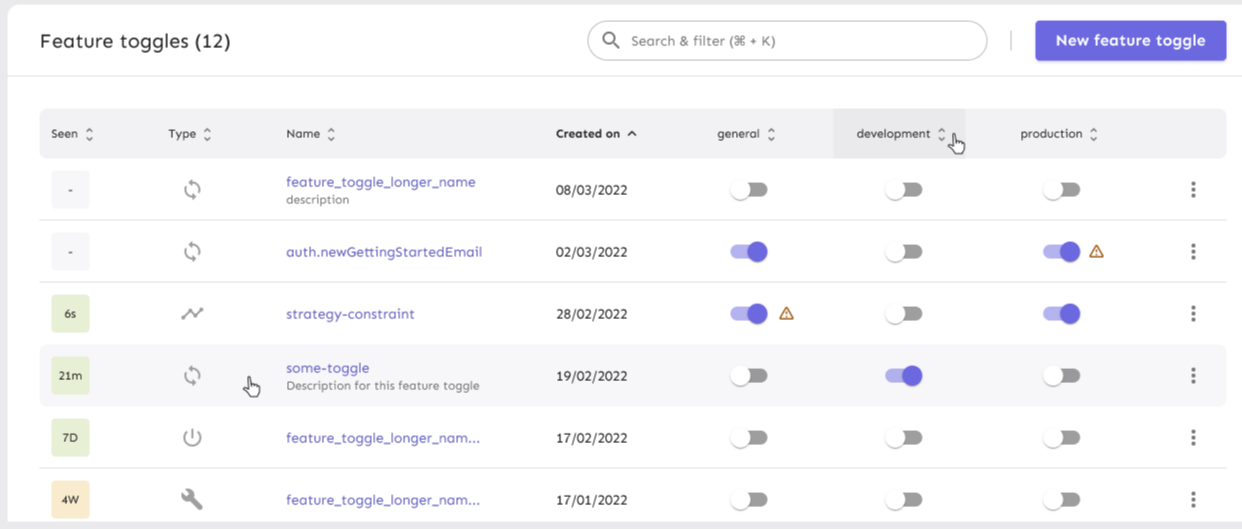This commit changes our linter/formatter to biome (https://biomejs.dev/)
Causing our prehook to run almost instantly, and our "yarn lint" task to
run in sub 100ms.
Some trade-offs:
* Biome isn't quite as well established as ESLint
* Are we ready to install a different vscode plugin (the biome plugin)
instead of the prettier plugin
The configuration set for biome also has a set of recommended rules,
this is turned on by default, in order to get to something that was
mergeable I have turned off a couple the rules we seemed to violate the
most, that we also explicitly told eslint to ignore.
## About the changes
Add warnings when we detect something might be wrong with the customer
configuration, in particular with regard to variants configuration
## Rationale
Moving from variants per feature to variants per environment will allow
users to have fine-grained permissions and more control over variants on
different environments: #2254
But because this requires an additional step of copying variants to
other environments, we identified the potential risk of users forgetting
to follow this step. To keep them informed about this, we're introducing
a warning sign after a toggle is enabled when we detect that:
1. The environment is enabled without variants
2. Other enabled environments have variants
This situation would be a problem if you rely on `getVariant` method
from the SDK, because without variants you'll receive the default
variant. Probably, not what you'd expect after enabling the toggle, but
there are situations where this might be correct. Because of the latter,
we thought that adding a warning and letting the user handle the
situation was the best solution.
## UI sketches


Co-authored-by: Nuno Góis <github@nunogois.com>
## About the changes
This PR adds the ability to push variants to multiple environments
overriding the existing variants.
Relates to [roadmap](https://github.com/orgs/Unleash/projects/10) item:
#2254
**Note:** This won't fail if there are variants in other environments, because the operation wouldn't be idempotent. It should have that property because setting variants to 1 or more environments once or twice should not make a difference
## About the changes
Variants are now stored in each environment rather than in the feature
toggle. This enables RBAC, suggest changes, etc to also apply to
variants.
Relates to [roadmap](https://github.com/orgs/Unleash/projects/10) item:
#2254
### Important files
- **src/lib/db/feature-strategy-store.ts** a complex query was moved to
a view named `features_view`
- **src/lib/services/state-service.ts** export version number increased
due to the new format
## Discussion points
We're keeping the old column as a safeguard to be able to go back
Co-authored-by: sighphyre <liquidwicked64@gmail.com>
Co-authored-by: Christopher Kolstad <chriswk@getunleash.ai>
fix: broken UI when importing features into environments which are not linked to the feature's project
## Related to
- PR: https://github.com/Unleash/unleash/pull/2209
- Issue: https://github.com/Unleash/unleash/issues/2186
- Issue: https://github.com/Unleash/unleash/issues/2193
## Expected behaviour:
After importing we should see:

## About the changes
**The problem:** when we import we have projects, features and
environments. Each feature belongs to a project (this is by default and
the imported file enforces that). The links between projects and
features, or projects and environments, depend on us creating those
relationships. When we add a feature to an environment we're not
validating that the project and the environment are connected. Because
of that, in some situations (like in this test), we can end up with a
project with features but no environment.
This breaks a weak constraint we had which is that all projects should
have at least one environment.
**This PR makes the following assumption when importing**: _if a feature
is added to an environment, and that environment is still not linked to
the project that feature belongs to, then the project and environments
have to be linked_. The rationale behind this is that the user couldn't
have generated this export file without the project and environment
being linked together.